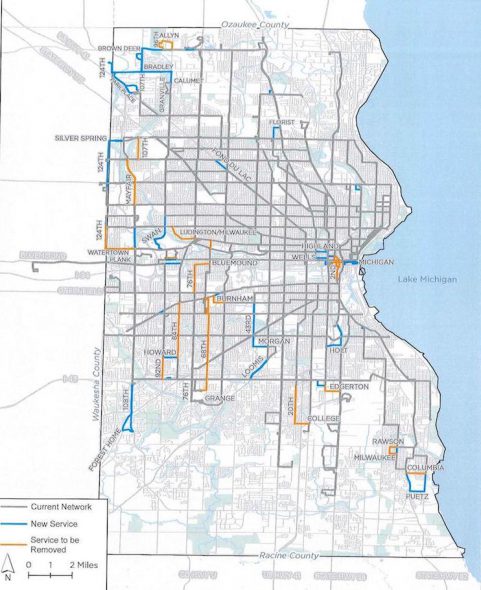Bus System Redesign Approved
More frequent service and shorter travel times. MCTS will implement changes in 2021.

How high-frequency routes are added under MCTS NEXT.
Starting next year, The Milwaukee County Transit System (MCTS) will begin making changes to bus service as part of a long planned redesign of the entire system.
For more than two years the Milwaukee County Transit System has been planning a new system called MCTS NEXT that invests resources in high-frequency service and shorter travel times. The final product will be a system where bus service is concentrated on a number of high-frequency routes, with buses coming every 15 minutes or less, and faster travel times
MCTS set about planning this new system with a goal to provide more residents with frequent and reliable bus service, to make the network more intuitive to use for the average rider, and to lower the cost per-passenger of transit service.
Recently, the Milwaukee County Board of Supervisors approved the MCTS NEXT route map, which has high-frequency service along 60% of routes and regular, or low-frequency service on 40% of routes. This was the most popular balance of routes when the transit agency engaged in public outreach on the system redesign.

Route Impacts Under MCTS NEXT.
There are currently 10 high frequency routes in the system and the map approved by supervisors adds an additional 6 high-frequency routes. “We know the best routes in the system today are high frequency routes,” Tom Winter, director of schedule and planning, told the county board’s Transportation, Public Works and Transit Committee. And this plan, Winter said, is a “step in the right direction for turning around those ridership declines.”
In order to increase frequency along those additional six routes, service will be pulled away from lightly used areas of the system. However, planners managed to design the new map without cutting any whole routes; instead, chunks of low-ridership routes have been taken out or some routes were shifted to daytime only — where evening ridership was incredibly low and didn’t justify maintaining the service, according to MCTS. The eliminated service areas directly affect only 0.5% of all riders in the system, Winter said.
To reduce travel times, the system will undertake what it calls “bus stop balancing”. That is, bus stops will be removed along routes to make the stops more evenly spaced out, while still allowing for walkability, according to MCTS. This in turn allows faster bus speeds and shorter travel times.
Along with routes being eliminated, this was one of the pieces of the system redesign that causes concern throughout the planning process. While collecting public feedback, 60% of respondents did say they would be willing to walk a little further to a stop if it meant shorter travel times.
Planners managed to design a network where 85% of riders will still be able to use the bus stop they are using on the current system. And the other 15% will have to walk an extra one or two blocks.
Now that the map has been approved, MCTS is working on a schedule for rolling out the changes to the system starting in 2021.
Because of Milwaukee County’s limited ability to finance projects, MCTS NEXT was designed to be budget neutral. The transit system couldn’t add new service, and instead had to shuffle service around and remove underused routes — relative to others — from the system.
97% of the population currently living within one quarter-mile of a bus stop under the current transit system will still have service under the new system, Winter said. And the transit agency estimates that approximately 166,000 additional people will live along high-frequency routes when the system is implemented.
Winter told the committee in July that planners approached the redesign with an eye to racial equity, and moved routes around to add service to routes and neighborhoods that are made up largely of persons of color. MCTS also estimates that approximately 90,000 people of color will gain access to a high frequency route, he said.
Approximately 33,000 additional people with limited income will be living near a high-frequency route and approximately 43,000 more jobs will be along them as well, according to MCTS. Winter said 100% of the jobs served by the current system will be served by MCTS NEXT.
The City of Milwaukee Department of Public Works, The Southeastern Wisconsin Regional Planning Commission (SEWRPC) and the Milwaukee Transit Riders Union have both endorsed the redesigned system. The Amalgamated Transit Union Local 998, which represents transit employees, however, has not.
But MCTS officials said they did consult with ATU on routes. And one of their requests was built into the final design: that all routes have a restroom at the end or layover point.
When the board approved the new system, the only three supervisors who voted against it were John Weishan, Jr., Supreme Moore Omokunde and Eddie Cullen. And they are the three supervisors with the closest ties to the transit union.
New High-Frequency Routes Include:
- New Orange Line – National Avenue – Greenfield Avenue
- New Route 15 – Kinnickinnic – Holton
- Route 35 – 35th Street
- Route 51 – Oklahoma Avenue
- New Route 60 – N. and S. 60th Street
- New Route 76 – N. and S. 76th Street
Route Changes Intended to Advance Racial Equity Include:
- Route 35 was converted into a high frequency route and will now serve a grocery story at S. 60th Street and W. Layton Avenue.
- The BlueLine was extended to N. 124th and W. Bradley Rd. adding access to three grocery stores.
- New Route 65 provides Hopkins Street residents access to more destinations with service along Capitol Drive, N. Fond du Lac Avenue, and W. Congress Street to N. 92nd Street. There will also be more frequent weekend service.
- New Route 88 makes service along Brown Deer Road simpler by having one route that travels from Green Bay Avenue to N. 124th Street and W. Bradley Road.
If you think stories like this are important, become a member of Urban Milwaukee and help support real, independent journalism. Plus you get some cool added benefits.
MKE County
-
Fellow Judge Testifies in Dugan Case
 Dec 16th, 2025 by Graham Kilmer
Dec 16th, 2025 by Graham Kilmer
-
Key Questions in Dugan Trial Take Shape on First Day
 Dec 15th, 2025 by Graham Kilmer
Dec 15th, 2025 by Graham Kilmer
-
FTA Tells Milwaukee to Crack Down on Fare Evasion — Even Where Fares Don’t Exist
 Dec 12th, 2025 by Graham Kilmer
Dec 12th, 2025 by Graham Kilmer
Transportation
-
Congestion Pricing Cuts Air Pollution in New York City
 Dec 14th, 2025 by Jeff Wood
Dec 14th, 2025 by Jeff Wood
-
FTA Tells Milwaukee to Crack Down on Fare Evasion — Even Where Fares Don’t Exist
 Dec 12th, 2025 by Graham Kilmer
Dec 12th, 2025 by Graham Kilmer
-
Will GOGO’s Bus Service Ever Get Going?
 Dec 9th, 2025 by Jeramey Jannene
Dec 9th, 2025 by Jeramey Jannene























While the proposed bus system re-do is interesting, it seems limited to re-configuring the existing service and ignores parts of the County that need, but lack, service today:
• Commerce Street
This is a booming, densely populated neighborhood in the heart of the City that lacks bus service and gets none in the re-design.
Perhaps alternate, weekday trips on the new “Orange” route could be extended to UWM via Commerce.
• Lincoln Memorial Drive
This is a major recreation area, perhaps Milwaukee County’s largest (not to mention also a minor employment center) that is only reachable by car, bike, or a long, steep walk from the top of the bluff.
Why not extend Route 22 (which already ends near the north end of Lincoln Memorial Drive) to Michigan St downtown during daylight hours where it could connect with many other bus routes? Besides serving lakeside parks (and possibly cutting travel time between UWM and downtown), this extension would directly connect (no transfer needed) downtown to several square miles of the north side that currently lack direct downtown service.
• Brown Deer Road
Although the bus system extends north to Brown Deer Road, no bus crosses the Milwaukee River north of Silver Spring, 4 miles south of Brown Deer, forcing people to detour up to 16 miles (round trip) and waiting for extra connecting buses on the way.
Why not extend Route 68 westward about 2 miles to Green Bay Rd where it would connect with Routes 12 & 88?
• Hampton Avenue
Route 11 ends less than two miles from potential connections with 3 other routes: 14, 68, & Green.
Why not extend Route 11 about 2 miles (through Lincoln Park) to Marborough Drive? And, if that were done, maybe it could be extended another mile-and-a-half to UWM on weekdays.